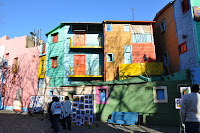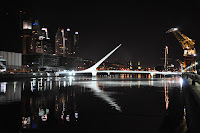 I’m in Buenos Aires this week for work and decided to come a day early so I could visit the city a little bit. The trip entailed an afternoon flight to London followed by an overnight flight to Buenos Aires via Sao Paolo (to change the flight crew – we had to stay on the plane). Door to door, it ended up being nearly as long as the travel time to Melbourne. Who knew?
I’m in Buenos Aires this week for work and decided to come a day early so I could visit the city a little bit. The trip entailed an afternoon flight to London followed by an overnight flight to Buenos Aires via Sao Paolo (to change the flight crew – we had to stay on the plane). Door to door, it ended up being nearly as long as the travel time to Melbourne. Who knew?During the cab ride from the airport I was forced to (try to) speak with the driver in Spanish since he didn’t speak English. It seems that my brain has reached capacity from a language perspective, as things that used to come easily in Spanish were a struggle. And in many cases, French just seemed to come out instead – as if some sort of internal wires were crossed. The optimist in me (at least what exists of him) hopes that this is a sign that my French is improving.
I’m staying in Puerto Madero – the old port area of the city – which is on the Rio Plata and has gone through a significant revitalization in recent years. Not far from the hotel is the Puente de la Mujer, which is an interesting bridge that “swings” open so that boats can pass through the channel that it spans.
 As a quick aside, the Wikitravel page on Buenos Aires notes that Puerto Madero has a mixture of restaurants “ranging from high-end American chains such as Hooters and TGIFridays…” Well, I guess one man’s trash is another man’s treasure as the saying goes (the second man being the one who wrote the Wikitravel blurb, of course).
As a quick aside, the Wikitravel page on Buenos Aires notes that Puerto Madero has a mixture of restaurants “ranging from high-end American chains such as Hooters and TGIFridays…” Well, I guess one man’s trash is another man’s treasure as the saying goes (the second man being the one who wrote the Wikitravel blurb, of course).I began my visit with an afternoon tour of the city that I booked through the hotel. In addition to the driver and the guide, there were three other tourists – one of which was a French woman who grew up near Geneva, coincidentally. During the ride, the guide would discuss the history of the Argentina / Buenos Aires and provide an overview of the upcoming stops. She seemed to really enjoy her job a lot and had a nice sense of humor.
The guide’s tour intro included a number of interesting things about the country. For example, although the soil in Argentina is quite fertile, the country was effectively “tree-less” prior to the arrival of Europeans. Nearly all of the trees in the country today trace their roots (no pun intended) back to Europe.
In addition, all of the cobblestones of the older streets are from Europe as well (apparently such rocks are another natural resource that Argentina lacks). The cobblestones were simply used as ballast for the ships coming to Argentina and were expected to be replaced by gold and silver for the return voyage. Unfortunately for the explorers, however, Argentina did not have any such loot (which makes "Argentina" a bit of a misnomer…).
The first major stop was the Plaza de Mayo, which was the site of the 1810 revolution that led to Argentina's independence from Spain. It is adjacent to the Casa Rosada (literally the “pink house”, where the Argentine president lives) and the Metropolitan cathedral. When we arrived there was a celebration / performance taking place so we stayed for a while to watch.




The Metropolitan Cathedral dates back to the 16th century and from the outside looks kind of like it could be an ancient Greek temple or Federal court house. The inside is very impressive – particularly the Venetian-style mosaic floor. There is also a mausoleum for the famous general San Martín as well as a Jesus sculpture that is somehow tied to the 1978 World Cup that was won by Argentina.




We then visited the San Telmo neighborhood, which was very lively and had a number of streets that were lined with booths selling a broad assortment of goods. The booth in the picture below stood out the most – I’m not sure who planned to buy something there, but I don’t really want to meet them. I didn’t notice at the time, but the vendor looks kind of scary.
 Here's a picture of a group that was playing tango music. The singer (not pictured, unfortunately) was particularly good.
Here's a picture of a group that was playing tango music. The singer (not pictured, unfortunately) was particularly good. And here’s a picture of (part of) a church that caught my attention.
And here’s a picture of (part of) a church that caught my attention. Next we headed to La Boca, which is well known for its colorful houses and popular football (soccer) team. The story behind the house colors is interesting. Given the poverty in the area, people would simply paint their houses with whatever paint was left over from the ships in the nearby harbor. As a result, the neighborhood has a bright, rainbow feel to it.
Next we headed to La Boca, which is well known for its colorful houses and popular football (soccer) team. The story behind the house colors is interesting. Given the poverty in the area, people would simply paint their houses with whatever paint was left over from the ships in the nearby harbor. As a result, the neighborhood has a bright, rainbow feel to it.

The story behind the colors for the Boca Juniors football team is also interesting. In 1906 the team had to change them and decided to use the colors of the flag from the next ship to sail into the harbor. The ship turned out to be from Sweden and the team thus adopted yellow and blue of the Swedish flag.
 We then drove around for a while through many of the neighborhoods (Palermo, Recoleta, Retiro) and saw a number of sights such as the Monumental Tower and the Floralis Generica Monument.
We then drove around for a while through many of the neighborhoods (Palermo, Recoleta, Retiro) and saw a number of sights such as the Monumental Tower and the Floralis Generica Monument.

For our last stop we went to the famous Recoleta cemetery, which reminded me a bit of Père Lachaise in Paris (albeit without the hills). As can be seen from the pictures, the mausoleums are quite impressive.




The most visited mausoleum in the cemetery is the one that is the final resting place of Maria Eva Duarte de Perón (Evita).
 The driver nicely offered to drop us off at our preferred spot along the tour route and everyone decided to go with San Telmo in order to return to all of the outdoor activities that were taking place.
The driver nicely offered to drop us off at our preferred spot along the tour route and everyone decided to go with San Telmo in order to return to all of the outdoor activities that were taking place.

I browsed the street booths for a bit to pick up some souvenirs and then stopped to watch some of street performers. The groups of percussionists in particular were very fun to watch.


 By this point it had started to get late (and cold for that matter – it’s winter), so I headed back to the hotel. On the walk back there was a bicentennial celebration going on in the Plaza de Mayo. The light show and music were very nice so I decided to brave the cold for a bit to enjoy the celebration with the locals.
By this point it had started to get late (and cold for that matter – it’s winter), so I headed back to the hotel. On the walk back there was a bicentennial celebration going on in the Plaza de Mayo. The light show and music were very nice so I decided to brave the cold for a bit to enjoy the celebration with the locals.



 And here are some pictures of the bridge by the hotel that I took during the walk back. The giant dinosaur-looking thing in the first picture is a German crane, of which there are numerous along the water. I believe that most are no longer functional but instead remain solely as artistic remnants of the past.
And here are some pictures of the bridge by the hotel that I took during the walk back. The giant dinosaur-looking thing in the first picture is a German crane, of which there are numerous along the water. I believe that most are no longer functional but instead remain solely as artistic remnants of the past.


No comments:
Post a Comment